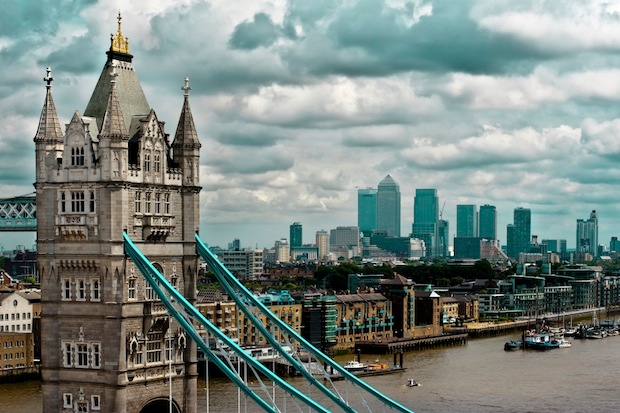For a long time my view of the Imperial Capital — as, like other Scots, I am still prone to considering London — was borrowed from Joseph Conrad’s description of its riverside: ‘It is a thing grown up, not made. It recalls a jungle by the confused, varied and impenetrable aspect of the buildings that line the shore, not according to a planned purpose, but as if sprung up by accident from scattered seeds. Like the matted growth of bushes and creepers veiling the silent depths of an unexplored wilderness, they hide the depths of London’s infinitely varied, vigorous, seething life.’ London was mysterious, huge and confusing. I disliked it intensely.
Times change. London seems a place transformed these days. It fizzes. By the end of next year, it is estimated, more than 8.6 million people will live in London — more than at any point in its history. It seems typically British that more time is spent worrying about this obvious success than celebrating it. Ours is a country in which success comes with a catch.
There is much talk of the London problem and the need to ‘rebalance’. Last year Neil O’Brien, now chief policy adviser to George Osborne, warned in these pages about London’s ‘overwhelming gravitational attraction’. But is this new? It seems improbable, given that a greater share of Britain’s population chose to live in London before the second world war than today. London has always been a behemoth. What has changed in the past 20 years is that the city’s long post-war decline has been reversed.
No wonder, then, that it has become fashionable to suggest London is again a place apart. In the 1920s, the novelist Joseph Roth said that Berlin ‘now exists outside Germany, outside Europe. It is its own capital.’ The same is said of London; some go so far as to consider it a quasi-independent city state in everything bar its political infrastructure. As in New York, a third of its population are immigrants. Economic output, per head, is almost three times greater in west London than Edinburgh, Britain’s second most prosperous city. Who can blame Mayor Boris for complaining that central government swallows 93 per cent of London-sourced tax revenue? And if Scotland (with its smaller population) is to be given power to set its own rate of income tax, why can’t London? There is no good answer — save to admit that the rest of Britain needs the capital’s money.
London’s success is, like many apparently new developments, a reminder of how often things revert to how they used to be. It is a long time since London was a purely English city. Its huge Scottish and Irish and Welsh populations marked it out as a truly British city when Britishness was still considered something simple and uncomplicated. And of course it was also an imperial city, the capital of a mighty empire. It is still a Commonwealth city (as evidenced by the arrivals of Lynton Crosby, Mark Carney and many others from the ‘white’ and ‘new’ Commonwealths) but it is also, now and again, a global metropolis. Perhaps the only true metropolis in Europe.
If you had offered me the choice of living in London or New York 20 years ago I would have chosen to cross the Atlantic. Now I am not so sure. London has caught up. It is ideally positioned between the old New World to the west and the new Asian powers to the east. It is crossroads and melting pot. Indeed, it is what one might term London’s ‘statelessness’ that is a large part of its global appeal and success. It does not matter where you came from or what you did before you arrived. All that counts is being here now and what you do in the future. However improbable it may seem, London has become a liberating place. The vast and impersonal city sets you free.
In fact London’s multicoloured, polyglot appearance is a demonstration of the city’s capacity for entrepreneurial renewal. It has opened itself to the world and reaped the benefit of doing so. And in doing so it has shown how the idea of Britain itself can change. Less white, less Protestant; more relaxed, more tolerant. Better, too. Stateless London has helped redefine Britishness as a concept available to — or that can be earned by — almost anyone. At a time when Scottish Nationalists argue that Britain is clapped out and incapable of reinventing itself, London’s example matters well beyond the M25.
And contrast the capital’s success with Birmingham. Hard though it may be to recall, there was a time when Birmingham was, like London today, considered too successful for its own good. By the end of the 1950s, post-war planners persuaded the city council that it must ‘restrain the growth of population and employment potential within the city’. Birmingham’s population should be reduced by nearly a fifth. Industries should be relocated elsewhere to ‘balance’ the economy. By 1964 the Labour government argued Birmingham’s growth was ‘threatening’ and needed to be controlled before it ‘got out of hand’.
Well, they achieved their goal. ‘Rebalancing’ the economy required inflicting untold damage on the West Midlands without adding much compensatory value elsewhere. Nothing more demonstrates the inadequacy and futility of centralised planning than this inclination to treat cities as problems rather than engines for growth. A better government would set our cities free. Let them build; the people will come.
The challenges spawned by urban success are scarcely as intractable as those caused by urban failure. The problem is not that London is leaving the rest of Britain behind — the problem is that the rest of Britain is not enough like London. To which I would add this view from North Britain: if a man is tired of London, he is tired of Britain, too.







Comments